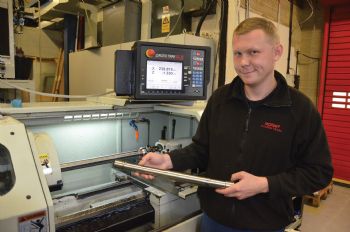
A series of seven turning operations — leading to the final hard-stage profile turning of nitriding steel shafts for use in helicopter rotor assemblies — is being performed on an XYZ Proturn SLX CNC lathe
(www.xyzmachinetools.com) incorporated into a special machining cell at Mollart Engin-eering, Chessington.
Almost 1,000 of these shafts have been produced on this flat-bed lathe in Mollart’s sub-contract facility in the last 12 months — mostly in batches of 10, due to the number of operations required and to help maintain a consistent schedule of deliveries. Staged processes on the lathe, which take around 40min overall, include profile and taper turning, grooving, recessing, facing and chamfering of the 3% chrome-molyvanadium toughened material.
One critical element of this job is the final profile turning of the 50mm-nominal-diameter heat-treated shaft, which includes a 34mm-diameter waist some 180mm long, a 7.5deg taper, various stepped diameters and a recess in the OD. While all tolerances have to be maintained within 0.05mm, there is also a final-stage concentricity of 20µm TIR between the finished bore and counter-bore over the 490mm overall length of the part.
Setter/operator Bartosz Lenczowski said: “The level of quality we can maintain in the final profiling is so important, not only due to the build-up of costs from the number of progressive operations, but also in order to ensure that we maintain the geometry — involving concentricity and straightness — between the bore, the counter-bore and
the outside profile.”